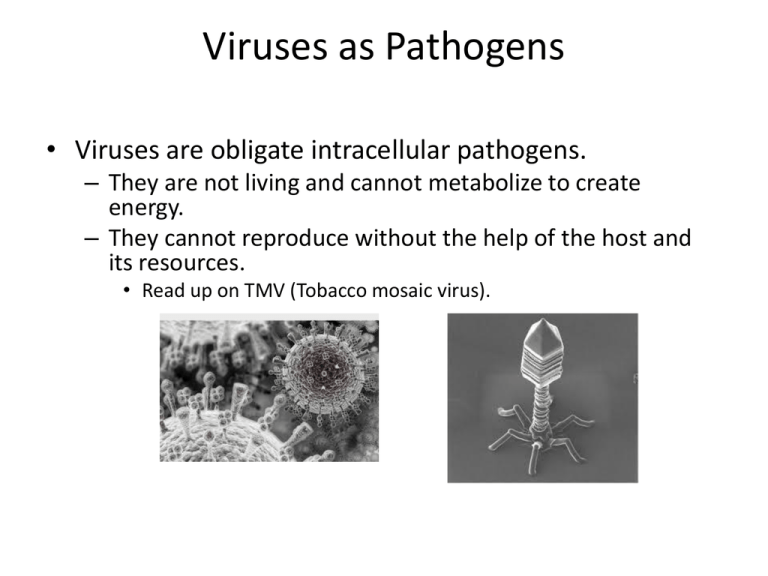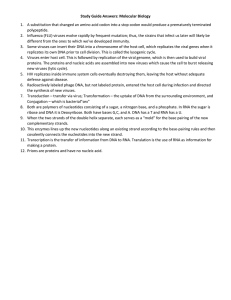Viruses as Pathogens
advertisement

Viruses as Pathogens • Viruses are obligate intracellular pathogens. – They are not living and cannot metabolize to create energy. – They cannot reproduce without the help of the host and its resources. • Read up on TMV (Tobacco mosaic virus). • extremely small (can fit thousands on a pinhead) – smallest 20nm (RBC 100mm, cardiac cell 1500mm, fat cell 6000mm) • nucleic acid – single or double stranded DNA or RNA • protein coat – may be a membranous envelope • derived from the membrane of the host • carry glycoproteins specific to the host cell • are usually animal viruses – may be called a capsid • made of specialized proteins called capsomeres • rod or polyhedral shaped • mostly found in bacteria that infect bacteria- bacteriophages Structure Viral infection Entering a host - beginning of an infection • infection begins when viral nucleic acids enter a host • T-phages inject DNA/RNA through their tail • envelope may fuse with host bringing in the nucleic material via endocytosis • Host range - defines who can be infected – can be narrow or broad • West Nile Virus - broad (birds, humans, equine) • measles & poliovirus narrow(humans – is dictated by the surface proteins present on the capsid/envelope Viral infection • Viral transmission – Horizontal - infection from an external source – Vertical - infection inherited from a parent (more common in plants) • Lytic Cycle - virulent phage – phage DNA enters cell (T4 through tail) – cell's DNA is hydrolyzed (separated) – Synthesis of viral DNA and proteins by host – Assembly of complete virus – release as the cell swells and bursts releasing many new complete viruses Types of infections • Lysogenic Cycle – replication without killing host – phage DNA enters cell • incorporates itself into the hosts DNA – Types of infections – now known as a prophage • may lie within the host dormant and create many cells carrying the prohage DNA – a trigger can switch the prophage into a lytic cycle – l phage is like the T4 but is not an obligate lysogenic virus - used in often research • Host Defense • recognize viral DNA and cut it up – evolution - favors host with different cell mechanisms receptors – restrictions enzymes (endonucleases) – vaccines • made of attenuated (viral pieces which are harmless) viruses – medicines • usually work by inhibiting viral DNA/RNA replication • virus – mutation resistant to restriction enzymes – lysogenic lifecycle Human Viruses • dsDNA – Adenoviris (common cold) – Herpesviris (herpes, chicken pox) – Poxvirus (smallpox, cowpox) • ssRNA template for mRNA – Orthomyxovirus (influenza) • ssRNA template for mRNA – Retrovirus (HIV) Virus Types • Retrovirus: HIV • ssRNA virus equipped with the enzyme reverse transcriptase – makes DNA from RNA - reverse process – DNA is inserted into host's DNA - HIV • now called a provirus – RNA pol II from the host now makes mRNA capable of making more viral ssRNA – provirus NEVER leaves the host • Viroids and Prions Virus Types – Viroids - circular pieces of RNA that infect plants • smaller than viruses • Caused by the misfolding of proteins • do not encode proteins but take over the regulatory system of its host cell causing mass replication – Prions • • • • • small viral pieces that cause diseases in animals cause neural diseases - mad cow (BSE), scrapie (sheep) slow onset time cannot be killed by heating and cooking no known cure




